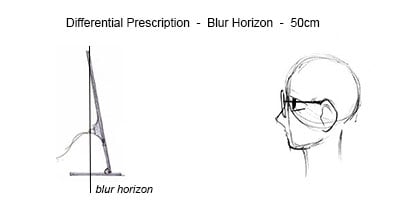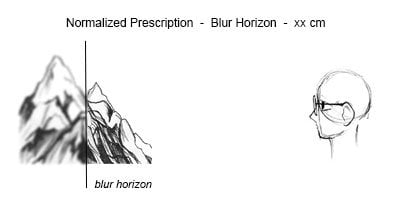Difference between revisions of Blur horizon
Viceroy Sam (talk | contribs) (→Video: ce diopter bubble, blur horizon snd edge of blur) |
No edit summary |
||
| (13 intermediate revisions by 4 users not shown) | |||
| Line 1: | Line 1: | ||
The '''blur horizon''' is the distance | The '''blur horizon''' (also known as [https://en.wikipedia.org/wiki/Far_point far point]) is the distance to the '''edge of blur''', where objects in the distance start to become [[blur]]ry. This effect is described as the '''diopter bubble''', because diopters are all about enlarging or shrinking the bubble of clear vision that you experience<ref>https://endmyopia.org/troubleshooting-uncomfortable-blur/ | ||
</ref>. | |||
Your blur horizon is primarily affected by the amount of correction you wear relative to the object you are trying to see. | Your blur horizon is primarily affected by the amount of correction you wear relative to the object you are trying to see. | ||
| Line 21: | Line 22: | ||
==Video== | ==Video== | ||
Explanation video of diopter bubble, blur horizon | Explanation video of diopter bubble, blur horizon and edge of blur. | ||
{{#ev:youtube|Xg30ILCRF1o|||||start=105&end=253}} | |||
==Blur Sensitivity/Edge of Clarity== | |||
[https://community.endmyopia.org/t/starting-an-em-youtube-channel-first-video-up/15007/12 Mentioned here] [https://community.endmyopia.org/t/starting-an-em-youtube-channel-first-video-up/15007/34 and here], it's explained in the associated video at the top of the page. | |||
==Blur tools== | |||
* A '''blur simulator''' that could show [http://www.billauer.co.il/simulator.html what you see without glassess] | |||
* '''Diopter visualiser''' of distance to blur https://anuwhub.github.io/MyopiaVisualiser/ | |||
==See also== | ==See also== | ||
Latest revision as of 07:55, 18 April 2022
The blur horizon (also known as far point) is the distance to the edge of blur, where objects in the distance start to become blurry. This effect is described as the diopter bubble, because diopters are all about enlarging or shrinking the bubble of clear vision that you experience[1].
Your blur horizon is primarily affected by the amount of correction you wear relative to the object you are trying to see.
How blur horizon is applied
Differentials
For differentials, the blur horizon is just enough to see the object.
In most cases, this is a screen. By wearing differentials, you increase your blur horizon just to the point where you can see the screen clearly, but the rest of the world is still somewhat or very blurry without wearing stronger correction. This is perfectly fine and part of the plan - differentials are only meant to correct you for a set distance.
Normalized
For normalized, the blur horizon is nearly unlimited.
Emphasis on nearly - it is crucial for the blur horizon to be slightly undercorrected and challenging your vision when compared to a full correction an optometrist is likely to give you. Being slightly undercorrected is perfect, as too much undercorrection will both stagnate improvements and cause you to live in blur unnecessarily.
Video
Explanation video of diopter bubble, blur horizon and edge of blur.
Blur Sensitivity/Edge of Clarity
Mentioned here and here, it's explained in the associated video at the top of the page.
Blur tools
- A blur simulator that could show what you see without glassess
- Diopter visualiser of distance to blur https://anuwhub.github.io/MyopiaVisualiser/
See also
Blog article explaining the Blur Horizon

